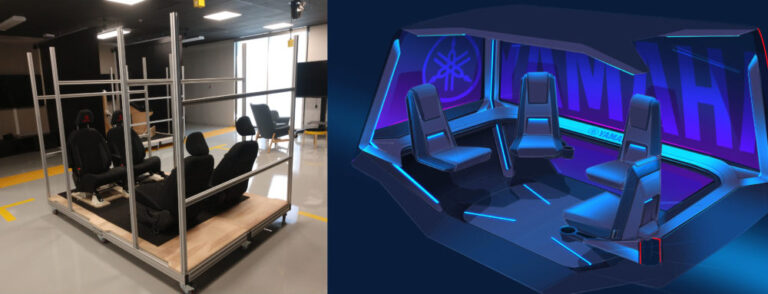J Antonio Islas-Munoz, head of transportation design, University of Cincinnati’s Design School (DAAP), examines how disruptive megatrends will shape the interior of the future ahead of his presentation at the Future of Automotive Interiors Conference in Novi, Michigan.
The way vehicles are designed is about to change as megatrends drastically reshape the urban environment over the next few decades. It is crucial that auto makers and other mobility providers understand what these future cities will look like and how people will live in them if they are to come on top of what Jeremy Rifkin calls the third industrial revolution. Vehicles in this future space will need to be created under a new approach, which is being enabled by technologies such as virtual reality (VR). This, in turn, will change the nature of automotive design studios and their workflows.
We live in a world in which mobility revolves around internal combustion engines powered by fossil fuels, with privately owned automobiles that are a symbol of status and success for their owners. This model has existed since the early 20th century, becoming prevalent worldwide after World War II.
Starting in the USA, a car, gas money, and an open road became a synonym of freedom and, with this romantic idea in mind, cities around the world were built around the personally-owned car. This decades-old paradigm created a set of stable vehicle architectures (i.e. front engine, cabin, booth), that allowed vehicle designers to mainly focus on making interiors and exteriors exciting, and thus, more successful in the marketplace. Vehicle design has responded to this status quo for decades to generate very specific workflows and spaces for their execution. With such a stable environment, automotive design studios developed the ability to create fantastic imagery to create emotionally provocative concepts. They bring these to reality by the fabrication of many expensive iterations of small and full-scale physical models. Everything is geared to obtain the cathartic physicality of a vehicle: the most exciting forms, materials, colors, and finishes possible.
Times change, and with them, this decades-old stability will no longer be the norm. Future megatrends such as autonomous mobility and the shared economy will disrupt the way people value vehicles and with that, the approach to create them. Deloitte projects that by 2035, 75% of vehicles in US urban areas will be driverless.
A vehicle that drives itself does not demand attention to the road, meaning that auto makers are beginning to shift from a cockpit paradigm to an enjoyable space as their interior design objective. Deloitte also states that 80% of vehicles in US cities will not be privately owned. In a future in which people buy less cars, but pay for more rides, the ‘driveway trophy’ value of a vehicle’s exterior will become less important. The main perceived value will likely be the best ride experience. This will only not come from the traditional physical look and feel of the interior as it has before. As the concept of a cockpit interior fades, the interactions with the vehicle will evolve beyond the operation of the machine into areas such as work or recreation.
In addition, paying per ride means that rather than having a generic interior layout created to meet most of the needs of a specific buyer, future vehicles can be designed to solve particular temporal needs or provide unique experiences. Future shared vehicle users are likely to request different interior configurations for commuting to work than for a special date over the weekend. They are also likely to pay differently for each. Paying per ride also means that new vehicle architectures will need to be developed, for instance, for moving one person all the time in the most efficient way rather than moving one, but enabling the ability to move seven sometimes.
This brings new challenges for vehicle design teams as they will need to develop new spaces and workflows that enable the creation of experiences that physical models can’t simulate. The new Future Mobility Center at the Ullman School of Design (University of Cincinnati) is a glimpse into the next iteration of vehicle design studios. The space is composed by a collaborative workspace that enables multidisciplinary work, an advanced visualization lab for traditional 2D development future concepts, and a space that mixes virtual reality development with physical prototyping. Vehicle interiors are created in virtual reality while the designer sits in a physical interior buck. Items generated to detail in immersive sketching tools such as Gravity Sketch, can be swiftly validated in the real world in a low fidelity prototype. The virtual geometry generated is refined into final CAD models that can be programmed into game engines to simulate interactivity and scenarios such as lighting, sound, and even a ride in a virtual city. High-fidelity virtual simulations on low-fidelity interior bucks reduces the amount of iterative, high-fidelity physical prototypes, streamlining the process and showing other aspects of the ride experience beyond the physicality of the vehicle.
We are about to see the human environment change drastically in the next few decades. Megatrends such as autonomous mobility and the shared economy will redefine the way vehicles and their interiors are designed. To respond to these realities, vehicle design studios will need to evolve and embrace new technologies and workflows. The Future Mobility Center at the University of Cincinnati under its Transportation Design program has taken an important step in this direction.
Don’t miss…
J Antonio Islas-Munoz, head of transportation design, DAAP, will deliver his presentation ‘Digitization and acceleration of design and development of the interior’ at 15:10pm on Day 2 (October 23), at The Future of Automotive Interiors Conference 2019 in Novi, Michigan.



